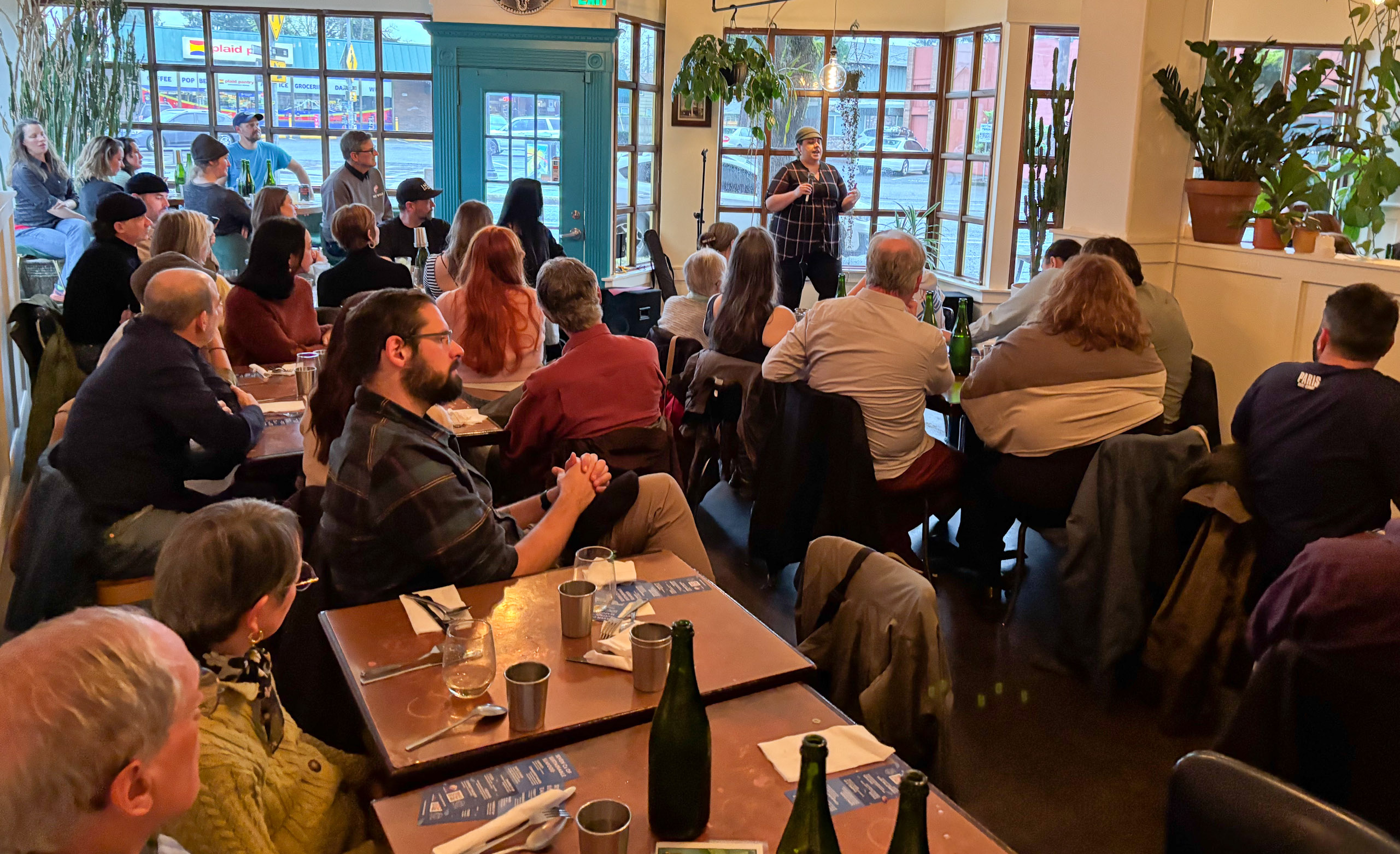Storytelling is an art form. Its biggest impact stems from authenticity, depth of knowledge, pace and connection. A genuine voice carries power, drawing listeners in. This was on full display at the KNOW FISH Dinner® at Bar Carlo restaurant in Portland, Oregon on April 6.
You could hear a pin drop as Seth Stewart talked about the sustainability lens that drives Yakobi Fisheries, the seafood company he and wife Anna run out of Pelican, AK, where Seth was born and where he learned to fish. He also shared the deep commitment he has to ensuring the fish that he and other fish harvesters Yakobi sources from is handled carefully, with extreme attention to quality. That, coupled with the fact that the fish can be traced back to individual boats, he said, is an important distinction when considering seafood sustainability.

Seth Stewart talking about his Alaska fishing roots and Yakobi Fisheries’ laser focus on quality.
That absolute focus in a restaurant packed with more than 70 people is a testament to the authenticity of his narrative. Every storyteller had a captivated audience.
We’d gathered to celebrate local seafood, talk about seafood with values, and why people should care where their seafood comes from.
Chef/host Melinda Archuleta welcomed folks to this community event, setting the tone for fabulous food choreographed with storytelling about the seafood folks would eat.
Clint Benson talked about his connection to Cook Inlet, Alaska, first as a deckhand, then as an entrepreneur “tending” the fishing boats by transporting their harvest to shore-based processors so they could continue to fish. He and daughter Allison launched Kenai-Red Fish Company in 2013 to bring wild sockeye salmon to customers in Portland and beyond. Like Seth, he talked about an almost maniacal fixation on quality as he described the smoked sockeye and salmon spread that were incorporated in the tasty appetizers that greeted folks shortly after they arrived.
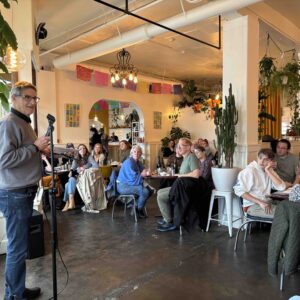
Clint Benson describes what makes wild caught sockeye salmon from the Cook Inlet so special.
A sustainable seafood business hinges on high quality … and relationships.
I took the opportunity to frame the conversation around what seafood with values means, starting with the local lens. Many of the folks in attendance raised their hands when asked if they regularly attend farmer’s markets. We talked about the need for more people to view seafood buying much the same as they would buy eggs from a farmer at the market. Over time, they get to know the farmer and the story of the eggs. They build a relationship based on trust. We discussed how that relationship provides seafood eaters the story of the seafood they’re buying. The definition of “local” has evolved in the past 15 years to mean a bit less about geography, and more about relationships.
Anna talked about direct sales to customers via the community supported fishery model (folks buy a share of the upcoming harvest for direct delivery later on) as an important facet of local seafood systems, and a way to connect with people in their community.
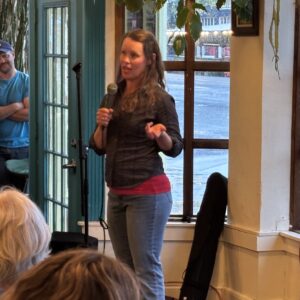
Anna Stewart discusses building relationships with customers via direct sales.
Both Anna and Seth, who live in Portland when not in Alaska during the fishing season, talked about whole fish utilization, and why they are so focused on eliminating waste in an industry where sometimes, the yield from two fillets represents only 30-40% of the entire fish weight. So for example, the halibut balls in a delicious miso broth with seaweed that Chef Cooper Wellington prepared were the product of halibut meat that had been scraped off the rack (the skeleton).
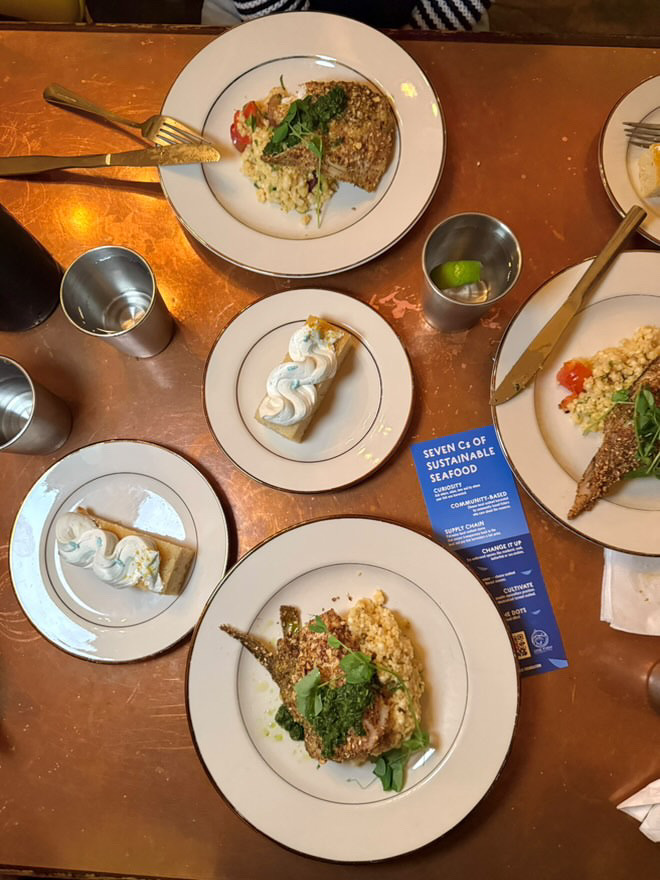
Halibut collars fried in a Dukkah rub. Photo: Judiaann Woo.
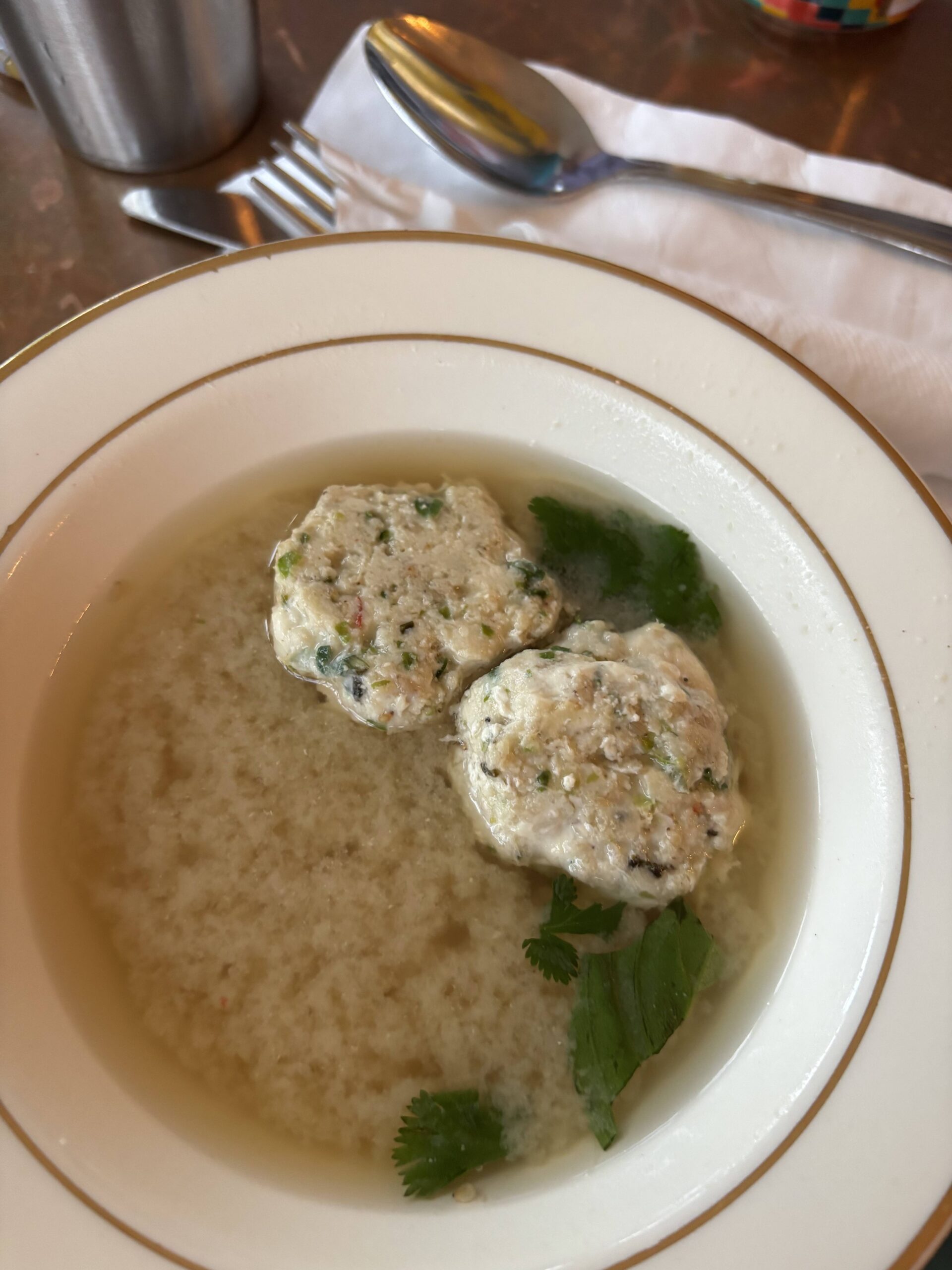
Halibut scraped off the rack.
Further driving that point home, Chef Cooper and the team also served halibut collars (the tender pocket of meat just behind the gills that also includes the fin) that were lightly fried in a crunchy cornmeal crust. Seth and Anna talked about educating their customer base on the benefits (cost, culinary and values) of buying whole fish, or at least, serving equally delicious parts that otherwise might go into a landfill.
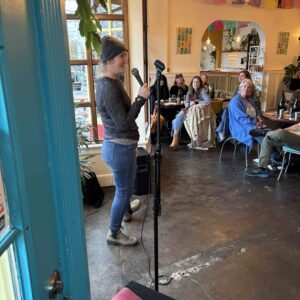
Kristen Penner describes her work making connections around values-based seafood and vibrant working waterfronts.
Kristen Penner talked about her unique role as a value chain coordinator working with Oregon Ocean Cluster, which is a collaboration aimed at boosting the state’s working waterfronts and coastal seafood economies. Think of Kristen’s role as someone who focuses on connecting fisherfolk, kelp and shellfish harvesters and other seafood producers with shared values to restaurants, retailers and programs aimed at supporting local seafood systems. That means amplifying the story about seafood with values and why it matters. She echoed the theme of whole fish utilization as a means of improving seafood sustainability.

Whole fish utilization in colorful jewelry.
Making fish leather, or the dried and cured skin of different fish is another means of eliminating waste along the supply chain. Fortunately, Elin Bascom of Solfiskur was on hand to demonstrate the beautiful jewelry she makes from salmon and cod skins from Iceland. She talked eloquently about the moment she learned what fish leather was and realized its potential as a great medium for her creative jewelry.
Again, the audience was zeroed in on her story.
Darlene Khalafi, a former consultant to Bar Carlo who is now managing the 100% Fish Program at Local Ocean Restaurant in Newport, Oregon echoed the points about whole fish utilization and consumers taking the initiative to learn the story of their seafood by asking questions. The consumer’s role in the equation is important to supporting local seafood and the restaurants who source directly from local fishermen.

Kevin Scribner reads a love poem to Bristol Bay’s hyper local AM radio station of the ’80s.
The theme of connectivity resurfaced shortly after feasting on humongous, flavor-filled salmon burgers when Kevin Scribner of Forever Wild Seafood and a member of the Slow Fish North America Oversight Team read a poem. It was a love letter to a time gone by when he fished for sockeye in Bristol Bay in the 80s. He described the hyper-local AM radio station often featuring high school students reading weather and fishing reports, local news and personal messages to the fishing crews out on the water. It was the primary means of communication during the intensive season when crews were away from their families for weeks.
We circled back on the themes of consumers’ responsibility of knowing the story of their seafood, building relationships and the connectivity of local seafood systems … the themes that drive businesses and organizations like Kenai Red, Yakobi Fisheries, Oregon Ocean Cluster, Solfiskur, Local Oceans and Bar Carlo.
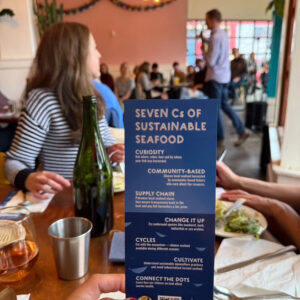 Throughout the storytelling, the food that Chef Cooper and his crew produced was the perfect complement to the storytelling, reinforcing the themes of nose-to-tail usage and experiencing what sustainable, wild caught seafood with values tastes like.
Throughout the storytelling, the food that Chef Cooper and his crew produced was the perfect complement to the storytelling, reinforcing the themes of nose-to-tail usage and experiencing what sustainable, wild caught seafood with values tastes like.
We challenged attendees to take the messaging with them, including the 7 Cs of Sustainable Seafood, and not only incorporate the practice into their own seafood purchasing habits, but to spread the word.
That’s how we move the needle. One authentic conversation or story at a time.
This event was a co-production of Slow Fish North America, One Fish Foundation and Slow Food USA. Big thanks to all the storytellers: Seth and Anna Stewart, Clint Benson, Kristen Penner, Elin Bascom, Darlene Khalafi and Kevin Scribner. Also, huge gratitude to Melinda Archuleta and Cooper Wellington at Bar Carlo for hosting such a wonderful event!


